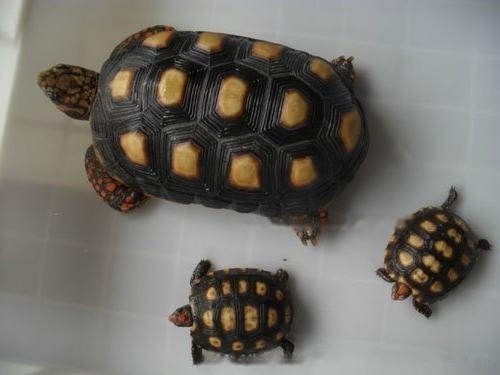The red-legged tortoise is a bit special to the environment, requiring high humidity and low temperature, so it is relatively difficult to control the temperature during the breeding process, and it is also difficult to care for it, then how do we gourd the red-legged tortoise and its What are the specific requirements for the breeding environment?

Red-legged tortoise
Red-legged tortoise care
1. About the bath of the red-legged tortoise
10 cm The following red-footed tortoises can be soaked every 2 days. If the environment is more than 10 cm, there is no problem if the environment is humid and soaked for 3 to 4 days. If they are larger, you can prepare a water basin and let them soak in water by themselves. When the tortoise is soaking in water, it is drinking water to promote excretion. It is possible to infer whether a tortoise is healthy based on acid and feces. If the stool is strip-shaped, with a certain green or dark green color, it is generally healthy, and the stool is not formed, indicating that there is too much water in the ingested food.
2. Breeding of red-footed tortoises
Although seasonal activity of red-footed tortoises may be noted, they may Eggs are laid at any time of the year, so it is recommended that females be provided with a nesting room filled with moist peat moss and sand at all times. The nesting room can be made from a large box with an open top, with a slope so that the turtles can climb in and out at will. Nesting chambers should be 1.2x1.2x0.6 meters in size and filled with moist nesting material, with a thickness of at least 50cm. It is important that there must be more than one male tortoise in a rearing group, and fighting between males is very important to induce breeding in red-footed tortoises.
Environmental requirements for red-legged tortoises
1. Humidity settings for red-legged tortoises
The red-legged tortoise is the most moisture-tolerant species of the tortoises. Humidity tolerance does not mean that the more humid the better, the humidity of the red-legged tortoise should be maintained at 50%~60%. Tortoise tortoises lose their appetite and even die. Because the red-legged tortoise is a forest tortoise, it needs high humidity. When feeding, you need to put a basin in which the whole tortoise can be immersed. If you see it drinking water for a long time, don't be scared, because every Only the red legs are like this, as if they are always thirsty.
2. Temperature requirements for red-footed tortoises
The temperature requirements for red-footed tortoises and Indian star tortoises are relatively low, 26~28℃ during the day , 23 ~ 25 ℃ at night belong to the appropriate range. For tortoises, a certain amount of temperature difference is a must. This can better promote the metabolism of the tortoise.
3. The importance of light for red-legged tortoises
When it comes to temperature, we need to talk about sunlight. Adequate sunbathing is very important for tortoises One thing, both long-wave UVA and short-wave UVB in natural sunlight are indispensable for biological growth. They can promote the synthesis of vitamin D3 in the body, vitamin D3 can promote calcium absorption, so that the turtle shell can grow better. Wild-raised turtles have finer textures than captive-raised turtles, which are related to diet and sunlight.
![[Dog Training 5] The training method of pet dog dining etiquette](/static/img/12192/12192_1.jpg)




